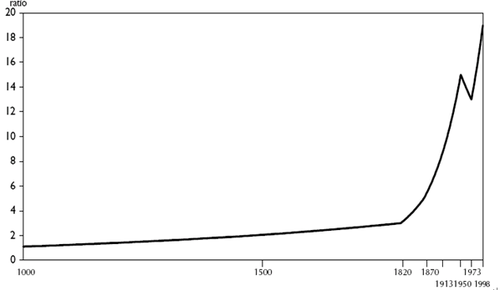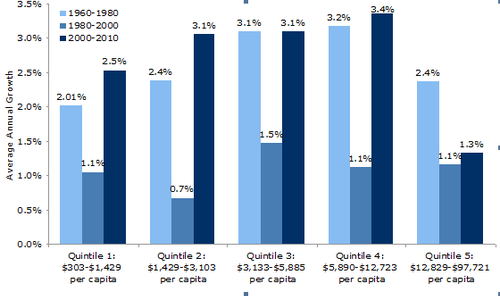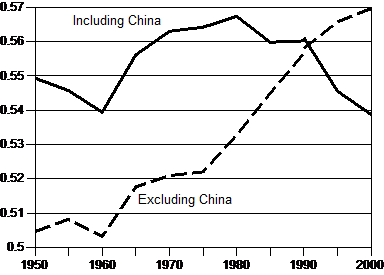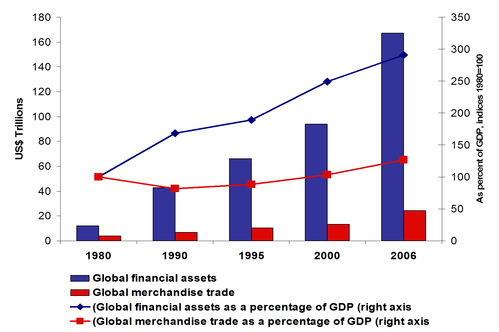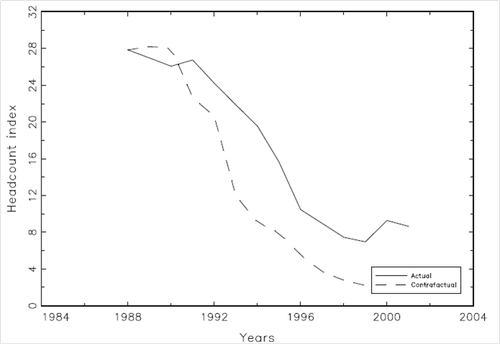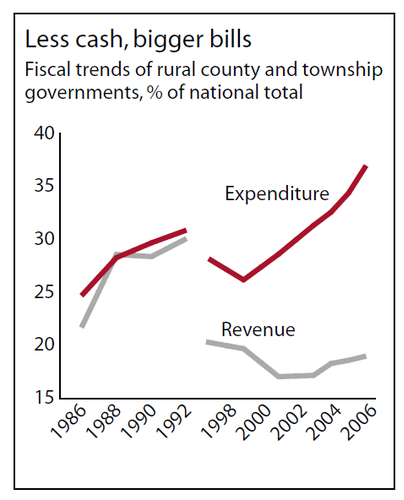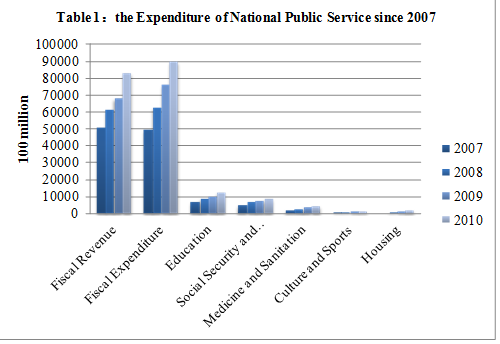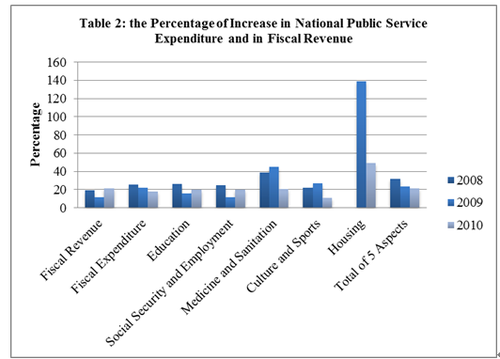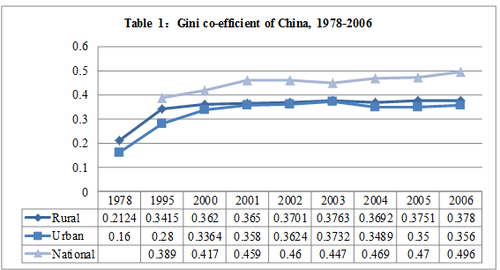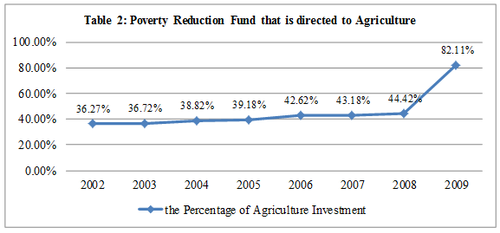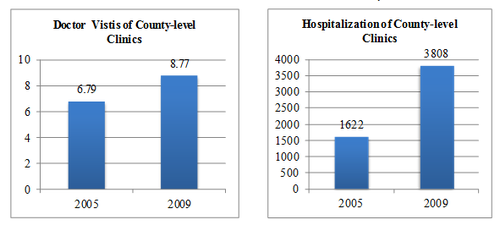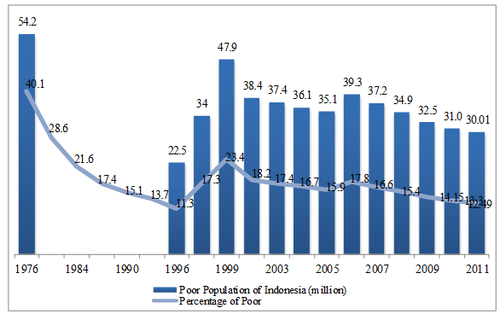Global Poverty Reduction and Development Forum 2011- Improvement of People’sLivelihoods and SustainablePovertyReduction
Chapter 5: 2011 Improvement of People’s Livelihoods and Sustainable Poverty Reduction
Background and Objectives
Poverty remains a crucial development issue, although the nature of poverty has fundamentally changed over the last few years. The multi-dimensional characteristics of poverty make the policy and programmatic responses very complex. And achieving cohesive public responses to poverty across relevant sectors is challenged by evolving new challenges such as climate change. Until recently, poverty has been mainly viewed as an issue for Least Developed Countries and Low Income Countries. However, nowadays poverty appears as a significant middle income country issue with an estimated two thirds of the world’s poor located in these countries. In Middle Income Countries, the rural to urban transition has often yet to be completed and urban poverty is a serious concern. Research indicates that the poor have been urbanizing even more rapidly than the population as a whole. Over the period 1993-2002, while the amount of poor people living on less than a dollar per day fell by 150 million in rural areas, it rose by 50 million in urban areas around the world.
For China, 2011 marked the beginning of the last decade for achieving an all-round Xiaokang society, the start of the 12th Five-Year Plan (FYP) (2011-2015), and the 5-year count-down for the MDGs globally. During the period of the 11th FYP (2006-2010), China’s average annual GDP growth was 11.2 per cent. Building on this achievement, China’s 12th FYP aims at shifting towards a more balanced and better quality growth trajectory, increasing public expenditure and promoting policies to enable household consumption. This will involve improvements in welfare policies to reduce households’ heavy reliance on savings. During the 2011 Boao Forum for Asia (BFA), President Hu Jintao stressed the importance of pursuing inclusive development. He stated: “We need to integrate our efforts to develop the economy in order to improve people’s well-being and to achieve coordinated economic and social development”.
To achieve this balanced development, the Chinese Government seeks to improve the management of the social welfare system, and to enhance participation within it –not only by civil society organizations and NGOs, but also by the corporate sector and the media. The Government considers essential to engage all relevant social sectors in this process. This shift in national priorities towards improving people’s well-being and social management is critical for poverty alleviation and the reduction of current levels of inequalities.
Under the 12th FYP, China’ specific areas of importance for its ongoing poverty reduction efforts are unifying safety net provision for rural and urban areas, addressing poverty within the rural-urban migrant population, improving access to health and education provision for poor households, and further developing microfinance and micro insurance schemes, particularly in relation to the impact of climate change on poor areas.
The 2011 Forum focused on the most recent development trends against the background of economic and financial turmoil, and alternative policy options. As its overarching theme, the Forum presented and discussed experiences, successes and challenges in empowering people to foster human development and increase the pace of poverty reduction, globally and in China.
In particular, the 2011 Global Poverty Reduction and Development Forum:
· Highlighted the most recent development trends related to human development and poverty reduction;
· Highlighted the current challenges that current growth models are facing, in particular regarding the issues of sustainability and inequalities and explore ways to improve the quality of growth, people’s well-being and poverty reduction in China and the world;
· Promoted international cooperation and exchange of information and experience in relation to improving people’s well-being and sustainable poverty reduction;
· Explored the role of government and civil society in developing pro-poor approaches in the areas of social policy, social management, as well as resource management and distribution;
· Marked the International Day of Poverty Eradication (October 17) by raising domestic and international public awareness and promoting the Millennium Development Goals (MDGs).
1. Opening Ceremony
|
Helen Clark, UNDP Administrator “Accelerating Poverty Reduction and Sustainable Human Development” |
• Poverty reduction and sustainable development require inclusive, target-oriented policies and environmentally, economically and socially sustainable growth
• Leaders have to change their ways of decision-making and policy planning into more inclusive and multi-perspective
• China, UN and the whole world must work together to achieve MDGs, green growth and sustainable human development
Reducing poverty and inequality and enhancing human development require target-oriented policies and inclusive, sustainable growth. Measures need to be taken on both multilateral and national levels and investment in sustainable human development must be prioritized.
UNDP is working closely with China to share good practices on poverty reduction and experiences of expanding opportunities and reducing inequalities. This includes working with Chinese government and ministries on promoting social inclusion for migrant workers and their families; and working to enhance women’s inclusion in the labor market.
Social protection is a critical investment in increasing resilience, for it enables people to sustain basic living standards even when shocks occur. Similarly, environmental protection is the foundation of sustainable human development. Progress and poverty reduction cannot be sustained if the ecosystems, on which life on this planet depends, are irreparably damaged.
The UN Conference on Sustainable Development in June 2012 is the opportunity for the world to promote a change in the way we make decisions – so that leaders instinctively think across the normal silos and design policies which consider economic, social, and environmental consequences simultaneously. Adopting the sustainability agenda will require concerted efforts and a willingness of leaders to learn from experience and to adapt existing practices. Countries will need integrated national and local policy frameworks, targeted incentives, and supportive global structures.
A strong outcome on energy in particular is needed at the Rio+20 Summit. Access to clean energy is critical for achieving green growth, sustainable human development, and accelerating progress towards the MDGs. The UN Secretary General has set an ambitious agenda for sustainable energy for all, with three goals to be reached by 2030: 1) ensuring universal access to modern energy services; 2) doubling the rate of improvement in energy efficiency; and 3) doubling the share of renewable energy in the global energy mix.
|
Hui Liangyu, Vice Premier of the State Council |
• Maintaining and improving people’s livelihoods are the ultimate goals of the more balanced economic development mode
• Employment, pension insurance, social security, housing, water safety, and education are among the key focus areas
• The rights and services of vulnerable groups such as women, children, elderly and the disabled will be protected
Currently, China’s poverty reduction and development aim at securing results already achieved in ensuring basic living necessities for the people, accelerating poverty elimination, improving natural environment, increasing development capacity, and narrowing development gaps. Great achievements notwithstanding, China still faces severe challenges in poverty reduction and development.
From this year on, the Chinese government will implement The Outline of 12th Five-Year Plan for the National Economic & Social Development of PRC (2011-2015) and The Outline for Poverty Reduction and Development of China's Rural Areas (2011-2020). One of the top priorities is to ensure that development benefits all the people. Improving people’s livelihoods should be regarded as the ultimate goal of the transformation of economic development mode. Increasing employment and efforts in adjusting income distribution are also crucial.
During the 12th Five Year Plan Period, China will carry out a series of action plans to improve people’s livelihoods. China will increase employment in both urban and rural areas; increase input in pension funds, realize full coverage for rural social pension insurance system, increase reimbursement rate of medical insurance, and raise the minimum living standards in rural and urban areas. Taxes will be alleviated from residents and a low-income housing project will be implemented to benefit both rural and urban residents. Employment and social security service systems will be perfected. It is expected that China’s socioeconomic development will be more inclusive after these actions, creating a more enabling environment for poverty reduction.
Drinking water safety, electricity for industrial and domestic uses, transportation and renovation of rural dilapidated houses are to be addressed in poor areas. Those areas will also experience development in education, medical health, cultural and social undertakings. Thus the rights and services of such vulnerable groups as women, children, elderly and the disabled will be protected. The central government will focus on increasing capital input and improving coordination in major clusters of poor areas. It will intensively exercise livelihood-related projects in education, health, culture, employment and social security.
International cooperation should be promoted to achieve the MDGs on time. Bilateral and multilateral cooperation mechanisms should be made full use of on various levels to maintain food and energy security, encourage mutually beneficial cooperation and achieve common progress. Developed countries should enhance their support and technological transfer to, and experience sharing with, developing countries. Developing countries, on their parts, should actively accelerate economic restructuring, try to transform economic growth modes to improve people’s livelihoods in a tangible way and realize sustainable growth. Meanwhile, international organizations should deepen their reforms in international financial and trade systems, strengthen international development aid, and thus enhance developing countries’ capability in sustainable poverty reduction.
2. Keynote Speech
|
Fan Xiaojian, Director of the State Council Leading Group Office of Poverty Alleviation and Development of China |
• Rural poverty alleviation measures have included creation of an agriculture subsidy system, investing in infrastructure including water, electricity, roads and gas; reforming the rural compulsory education administration system, providing better medical assistance to vulnerable groups and promoting a new rural pension system
• The rural poverty reduction and development strategy states that China will focus more on poverty clusters and invest more into education, health, culture, employment, social security and other livelihood-related projects
• Government also has to consolidate the new pattern of “great poverty reduction” featuring the inter-linkage of special poverty reduction, industry-based poverty reduction and society-based poverty reduction
In the past decade, China has witnessed great progress in poverty reduction in rural areas where population living in poverty has dropped significantly, people’s living standard increased by a large margin and infrastructure improved remarkably. As deeper changes are taking place in rural social undertakings, ecological and environmental policies in these areas begins to yield initial results.
In the past decade, central and local governments have played a leading role in poverty reduction and development in rural areas, fulfilling their due responsibility in this respect. Economic growth has been maintained while agricultural foundations have been consolidated. Encouraged social participation has been combined with enhanced international cooperation, even though China has relied mainly on its own to implement strategies in poverty reduction and development. An overall planning of both urban and rural areas has contributed to the scientific approach to development. Construction of an agriculture subsidy system has been accelerated, committing more input to rural infrastructure including water, electricity, gas and roads. The overall aim is to alleviate rural residents’ burdens while at the same time increase their income and promote agricultural development. The administrative system in rural compulsory education has been reformed, implemented the new rural cooperative medical system to provide better medical assistance to vulnerable groups, and pushed forward with pilot projects of the new rural pension system.
China has identified its rural poverty reduction and development strategy in the coming decade. The goals of which are: by 2020, target groups will have basic living necessities, access to compulsory education, basic medical services and housing. Increase in the net income of poverty-stricken rural residents has exceeded average national growth, while basic public services in these areas are nearing national average level. We also need to define more clearly the target groups and scopes of poverty reduction: the central government will focus more on poverty clusters and commit more inputs into education, health, culture, employment, social security and other livelihood-related projects. In the same time, we also need to consolidate the new pattern of “great poverty reduction”, which focuses on inter-linkage of special poverty reduction, industry-based poverty reduction and society-based poverty reduction; to improve policy system of poverty reduction; and to strengthen the sense of responsibility and development by accelerating poverty reduction legislations and incorporate legislative administration.
China’s poverty reduction cannot progress without the support from other countries worldwide. Similarly, global poverty reduction cannot advance without China’s efforts. Therefore, expanding international cooperation in anti-poverty undertakings is vital to our realization of the MDGs. China stands ready to enhance cooperation with the international community and to promote mechanism innovations in this respect through mutual learning and exchanges. We are willing to contribute by sharing our experience as well.
3. Panel Discussion: The Emerging Economies and Global Change
|
James Mirrlees, Nobel Prize Laureate in Economic Sciences (1996), Chinese University of Hong Kong, “The Relief of Poverty” |
• As a means of poverty reduction, the establishment of a nationwide public service guarantee system is likely to be hindered by the extensive nature of the system itself and by people’s inability to contribute regularly and timely to public institutions
• Cash transfer payment based on local information is likely to be the most effective method to directly reduce poverty
People’s demands are multi-dimensional, and so is poverty. It is a difficult and yet important task to measure multi-dimensional poverty, because such a measurement will enable us to understand more clearly the problems confronting the poor.
Economic theories suggest that we should redistribute income through taxation and allocate more redistributed income to the poor in the form of subsidies. Poverty reduction is an important by-product resulting from social transfer payment. Tax revenues of redistribution can ensure that everyone has minimum consumption ability and is entitled to a certain extent of education. We cannot, of course, impose a uniform solution on this issue because it is not likely that the standard model in developed countries will apply to all the countries in the world. That standard model requires taxation departments to predict all the revenues and base on the revenues to levy taxes and offer subsidies. It also requires adequate and on-time payments to public institutions. For some low-income countries, it is rather difficult to measure the income of the poorest, for they don’t have predictable income and finances due to unpredictable disasters and employment status.
The establishment of a nationwide public service guarantee system is likely to be hindered by the extensive nature of the system itself. Moreover, when projects and resources to be managed expand in such a system, corruption will happen. The cost of local transfer payment can be greatly reduced by making better use of local information. For instance, a basic scale of cash transfer payment can be determined by observing harvests in the local place or conducting grass root surveys to acquire detailed information about unemployment. By doing so, payments can be transferred in a well-targeted manner and costs in management and transfers will be greatly reduced.
Cash transfer payment based on local information is likely to be the most effective method to directly reduce poverty. This has been done quite successfully in Latin America. During such a process, institutional settings should be enhanced for coordination and administration, so as to better record local information and execute transfer payments.
Apart from cash transfer payment, subsidy is also an economic method to address poverty and indeed many successes have been achieved in this way. Subsidies in agricultural machinery and chemical fertilizers in India and China and loans related to agricultural development in Bangladesh are cases in point. We find, however, that sometimes administration plays a more important role in such a method. Without proper administration, those relatively rich people will falsely claim the subsidies and benefits of preferential policies. Therefore, if this method is to work, there must be a very effective way to allocate tax revenue to those really in need.
|
Jomo Sundaram, UN Assistant Secretary-General for Economic Development in UNDESA, “Growth, Inequality and Changes in Global Poverty Landscape and Emerging Economies” |
• Poverty reduction largely depends on rises in employment but in many places worldwide economic growth hasn’t increased employment opportunities
• The financial crisis has worsened inequality situation by decreasing investments in real economy and thus increasing food prices
• Secretary General of UN launched the Green Economy Initiative as an incentive mechanism to ensure food safety and the development of renewable resources. The initiative aims at creating employment opportunities and improving global infrastructures
In the past one thousand years, inequality among regions grew relatively slowly. Only during the last 200 years, fueled by rapid economic growth brought by industrial revolution, has inequality been growing at a greater speed.
World inequality accelerates
Welfare improvements and poverty reduction largely depend on employment creation but the jobless growth of the last few decades has worsened the situation. UNDESA divided countries into groups according to their GDP per capita and discovered that during the past five decades, per capital GDPs of all groups had decreased before they increased. Meanwhile, income inequality of all countries was always on the rise. Most countries have witnessed aggravating income inequality since the 1980s while only Northern European countries and a few South American countries previously measuring levels of high inequality had different experiences.
Average annual growth by income (1960-2010)
As seen from Gini coefficient, inequality among different countries is actually greater than inequality within certain countries. This situation is worsening at present. China’s rapid growth increased the income of relatively poor countries. If excluding all factors related to China, conclusion is that inequality among different countries has registered a remarkable increase. From the early 1960s to the beginning of the 21 century, per capita GDP in the poorest 20 countries increased by 26%; meanwhile that of the richest countries tripled. Similar conclusions can be drawn from the perspective of consumption.
Inter-country inequality (1950-2000)
Global income distribution
It is generally believed that trade benefits all countries. Five decades ago, however, trading process was quite different from what it is nowadays and it seems that trade is growing at a decreasing rate. Many believe that globalization is a manifestation of trade integration. Technically, financial integration is more important than trade integration because financial resources not only flow from rich countries to poor countries, but also from the poor ones to the rich ones.
Cross-border capital flows mainly to developed countries, which makes easier for the developed countries to use credit services. Low-cost credits in turn increase workers’ expenditure and further increase their demand. Bubbles in the credit sector triggered a chain of bubbles, especially in assets prices. Price upsurges in essence are closely related to increases in assets prices, but not to increases in labor costs. The inevitable burst of the bubbles is the root cause of the recent financial crisis.
Increase in global financial assets and trade (1980-2006)
The financial crisis worsened the issue of inequality in two ways: First, financial austerity. Second, policies that cause economic stagnation and decreased investment in real economic activities, such as agricultural production, which caused increase in food prices. Therefore, the Secretary General of UN launched the Green Economy Initiative as an incentive mechanism to ensure food safety and the development of renewable resources. The initiative aims at creating employment opportunities and improving global infrastructures.
|
Wang Yuan, Chief Economist, China Development Bank, “The Role of Financial Service in Poverty Reduction and Development – Practice of China Development Bank” |
The realization of MDGs depends on three factors: consensus of the international community; relevant policies and financial input from governments worldwide; and participation and support from corporations, including financial institutions. China Development Bank contributes to achieving the MDGs through inclusive financial services.
The tenet of China Development Bank is to enhance national strength, improve people’s livelihoods and stay committed to inclusive financial services. CDB is actively engaged in the “Three Rural” program and other grass root financial services related to people’s livelihoods, including SME loans, low-income housing loans, student loans, and medical service loans. To demonstrate the scope, SME financing has benefited 1.57 million small and medium sized businesses and self-employed households and by the end of 2010 it had created more than 4 million jobs. 3.8 million financially constrained students had been given study loans by the end of 2010.
At the international level, CDB aims at promoting local welfare via focusing on the development of local infrastructures, people’s livelihoods, employment, energy and environment to boost the local development capacity and the sustainable development capacity of cooperating countries. Examples of projects benefiting local economy and people’s livelihoods include a housing project for low-income families in Kenya and a cotton plantation in Malawi. CDB is committed to pushing the world economy towards balanced, inclusive and win-win development through financial cooperation. “Mutual trust, experience sharing, and common development” has been an important principle in the international cooperation.
|
Zhang Bo, Vice President of Chongqing Academy of Social Sciences, “Bridging three gaps, promoting common prosperity—Chongqing’s experience in exploring livelihood-oriented roads to development” |
• Chongqing’s poverty reduction policy system stresses fairness in income distribution and efficiency
• “Bridging gaps and achieving common prosperity” has facilitated Chongqing’s poverty reduction. Poverty-stricken rural population decreased by a large margin and rural residents in poor areas now enjoy noticeably higher incomes. Infrastructure in poor areas has also been greatly improved and poverty reduction input soared.
The basic direction of Chongqing’s exploration has been livelihood-oriented aiming at bridging gaps and achieving common prosperity. The key to this is to ensure fairness in primary income distribution and rapid growth of rural residents’ income. A prominent feature of Chongqing’s development policy is its systematic design.
Increasing income. Increasing income means to encourage the establishment of new enterprises, increasing employment opportunities, increasing rural residents’ property income and wages income. There are four ways to increase their property income: transforming rural collective ownership to a shareholding one; reconstructing rural housing; “three-rights”-backed mortgage; and land ticket trade.
Reducing expenditure. Reducing expenditure means to reduce rural Hukou, housing expenditure and burdens. First, we need to steadily reform the Hukou system to reduce rural population. Second, we will build 40 million square meters of public renting housing to reduce housing expenditures of mid and low-income families. Third, we will reduce the burdens on mid and low-income families through measures such as tax regulation.
Adjusting the distribution of gains. This means to increase the ratio of state-owned capital gains turned over to the Ministry of Finance, to adjust income distribution, and to adjust the minimum living standard.
Poverty reduction. This means to reduce poverty and help especially the young and the elderly. The “two-wing regions” are priorities of this task.
Highlighting top priorities. This means to identify the construction of a public service system, a regional economic center and modern small towns as top priorities.
“Bridging gaps and achieving common prosperity” has facilitated Chongqing’s poverty reduction. Poverty-stricken rural population decreased by a large margin and rural residents in poor areas now enjoy noticeably higher incomes. Infrastructure in poor areas has also been greatly improved and poverty reduction input soared.
4. Parallel Session 1: Macro-Planning for the Empowerment of the Poor
4.1 “Making fiscal policy work for inclusive growth and poverty reduction”
|
Carl Riskin, Queens College and Columbia University, “Poverty and its Links: Inequality, Imbalance and Central Transfers” |
• Poverty is a multidimensional problem; all policies and institutional changes should consider the implications for poverty and poverty-reduction
• To reduce poverty, China needs to maintain rapid economic growth, promote the opening and development of rural areas, and enhance social protection and insurance policies
China’s poverty reduction has attracted more attention to the correlation of poverty reduction with other economic phenomena such as income inequality and economic imbalance. Per capita income is negatively correlated with incidence of poverty and income gap. If income gap between rural and urban residents can be narrowed, high incidence of poverty is expected to fall.
Actual and counterfactual poverty reduction
Many factors contribute to the enlarging income gap, which undermines the role of economic development in poverty reduction. Both policy factors and market factors account for such a problem. In terms of market, in the beginning of China’s reform and opening-up, there were abundant labor surpluses, a fact that resulted in low basic compensations. Therefore, compensation gap was widened during the reform and opening-up period. However, in terms of policy, capital-intensive technologies were applied to lower down capital cost and this restricted the creation of job opportunities.
The remaining poverty-stricken population in China can be mainly grouped as: people living in remote areas, the disabled and the old and vulnerable groups that are prone to market volatility and reforms. Policies in response are:
Maintaining rapid economic growth to ensure high labor demand. However, as its advantages in the initial stage are exhausting, China is approaching the end of it fast growth period.
Promoting the opening and development of rural areas. Though agriculture does not serve as the main engine of overall economic growth, it is a major driving force behind poverty reduction. Currently, developing rural areas costs much more than in the initial stage, because new infrastructures need to be constructed, rural human capital needs to be improved and rural market needs to open more to achieve poverty reduction.
Social security and social insurance. Policies benefiting people in this respect are mainly funded by the central government. From 1994, a series of finance and tax reforms were carried out, resulting in rapidly increased central fiscal revenue which in turn enhanced the government’s ability in supporting education, health and social security. However, currently there is no clear responsibility division between the central and local governments. As a result, local governments, while lacking sufficient fiscal revenue to shoulder such responsibilities, are charged with a large portion of social welfare expenditure.
Large-scale transfer payment from the central government proves to be only a suboptimal solution and thus is not extensively applied in other places in the world. When funds are allocated from the central government to public service providers—local governments, there may occur issues such as low efficiency, low transparency and results unable to be monitored. As a result, the use of a large portion of these funds may deviate from the initial purpose. On the other hand, large-scale transfer payment from the central government will prevent local governments from enhancing their incentive mechanisms at their respective fiscal levels. A better solution would be to charge local governments with responsibilities that are compatible with their respective local fiscal revenue. This will inevitably mean that some responsibilities regarding people’s livelihood will be transferred to governments above the local level.
|
Su Ming, Researcher and Deputy Director of Research Institute for Fiscal Science, Ministry of Finance, “Fiscal Policy and Pro-poor Policy Orientation of China’s 12th Five-year Plan” |
There are five pro-poor aspects in the state finance and tax policy orientation of the 12th Five Year Plan:
1) Transformation of financial policy mode and allowing for proper deficit ratio.
Investments are mainly aimed at the “Three Rural” program, environmental protection, energy conservation and infrastructure construction.
2) Fiscal expenditure.
Fiscal expenditure is oriented towards the “Three Rural” program, enhancing social security, enterprise development and environmental policies.
3) Tax system reform and tax policies.
Taxes on certain sectors will be reduced with the reduction of business tax, in order to promote the development of China’s tertiary industry. In terms of income tax, more preferential policies will be implemented to encourage sectors engaged in the “three rural” program, environmental protection and poor areas of western China. For general products, the percentage of export tax rebate will be increased; while for highly-polluting, highly energy-consuming and resource-intensive products, the percentage of export tax rebate will be decreased. House property tax, environmental tax and carbon tax will be put into use as soon as possible. The Ministry of Finance will be charged with the levy of such taxes, with the cooperation of environmental protection institutions. 90% of environment tax revenue will be returned to local finance.
4) Inter-governmental fiscal relationship.
Each government’s share of income tax revenue should be stabilized and a mechanism for ensuring basic funding for county-level governments should be established. A reform featuring “direct governance of a county-level government by a provincial government” should be put in place with other auxiliary reforms.
5) Reform in budget administration.
Budget coverage should be expanded and more non-tax revenues should be included into budget. Transparency of budget should also be enhanced.
|
Paul J. Heytens, Country Director for Asian Development Bank’s Resident Mission in China, “Improving People’s Well-being and Accelerating Sustainable Poverty Reduction” |
Because of inequality, poverty reduction policies should be combined with fiscal policies, which balance economic development and adjust income distribution. Inequality endangers the sustainable development of the whole country, especially the poor areas, which further increases the need to enhance comprehensive and quality growth. To achieve sustainable poverty reduction, the following reforms are necessary:
First, social security expenditure has to be optimized to ensure more fairness in the distribution of public goods. The social security system has to be reformed and wages, pensions and other basic securities need to be increased. A comprehensive social security system can better stabilize domestic situation and push forward rapid development.
Second, tax policies have to be reformed to increase equality. This includes making the tax system more progressive and introducing new taxes such as inheritance tax.
Third, tax revenue has to be distributed more evenly between central and local governments, and distributive and equalizing mechanisms to support poorer provinces have to be introduced.
Fourth, new measures are needed to increase energy efficiency and improve water and land management. Green taxation of natural resource would act as a revenue source of environmental protection and rehabilitation. Carbon tax would also encourage the use of low-carbon technologies.
4.2 “Assessing the performance of public service delivery to the poor”
|
Liu Yunan, Deputy Director General, Department of Social Development of NDRC, “China’s practice in social security and improvement of people’s livelihood in recent years — Evaluation on social policies from a macro perspective” |
Currently, rural and urban residents’ material and cultural demands are increasing rapidly. The conflict between increasing demand in people’s livelihood and backward social production remains unchanged. China still faces severe challenges in ensuring basic living necessities and development of vulnerable groups. Therefore, three different interest levels have to be dealt with: the general interest of the public, the realistic interest in the current stage, and the special interests of different groups.
One major feature of the macro-economic control in the 11th Five Year Plan period was: the combination of maintaining economic growth and social stability while improving people’s livelihoods. Improving livelihoods is a driving force behind expanding domestic demand and transforming the economic development mode.
Compared with the 11th Five Year Plan, the Chinese government now has more clarified ideas and logic in implementing more specific socialist policies and providing public services. The government has not only clearly defined its orientations and set realistic goals but also highlighted basic security and paid more attention to system construction. It has improved the social security system to promote balanced education development and focused on the construction of the basic medical care system and the basic housing security system. And finally, the government has strengthened its planning and guidance and made rational allocations of public resources. Therefore, while measuring the overall development, one can say the social development is constantly advancing and social policies are successfully yielding effects.
|
Jairo Acuña-Alvaro, Policy Advisor in Public Administration Reform and Anti-Corruption, UNDP Vietnam, “Performance index in the provincial governance and public administration in Vietnam” |
• Public service performance index is mainly used to assess the effectiveness and efficiency of government administrative policies and services.
• Since public participation is vital to sustainable poverty reduction, in Vietnam, the public is encouraged to participate in measuring the public services in every dimension at every level, including the delivery and administration of public goods, education, infrastructures and medical insurance.
In the past 10 to 15 years, Vietnam has been carrying out political reforms in order to increase social welfare and improve people’s living standards. To ensure transparency, empower citizens and gather valuable information, the government has created mechanisms for citizens to participate in enhancing public services and policy formulation.
Public service performance index is mainly used to assess the effectiveness and efficiency of government administrative policies and services. It also includes opinions and multi-dimensional evaluation on the part of the public, thus creating multi-dimensional evaluation results. Vietnam has brought in some evaluation criterion generally used in other countries to formulate its own evaluation criterion. Therefore, policy formulation can cover greater aspects on a more general basis.
Government participation is very important in such an evaluation process. Once administrative and service policies are formulated, relevant systems and institutions should be established to mobilize implementation resources. Prior to this, an institution specialized in supervision is needed. During this process, the public is encouraged to participate in every dimension at every level, including the delivery and administration of public goods, education, infrastructure and medical insurance. Public participation is vital to sustainable poverty reduction.
In terms of public services, as each province has its own background, history and culture, policy effects differ from one province to another. Research has shown that policies tend to have greater effects in metropolis and fewer effects in areas lacking infrastructure. It has also shown that provinces with better governance experience better policy effects.
Vietnam’s experience offers the following insights: it is increased and enhanced public participation that avails citizens of better public resources and public services, that provides children with reasonable education and that creates a society where the sick are treated and the old are cared for. Each province should strengthen their research to better understand people’s living index and related policy effects. Stronger research also means more specific information and statistics for more effective policies. Through such analysis, the government will identify its advantages and disadvantages, and adjusts its policy orientation accordingly. Objective information also consolidates local policy-makers ideas and experience, thus facilitating the promulgation and implementation of poverty reduction policies.
4.3 “Urbanization and urban poverty: responses to addressing the needs of the poor”
|
Li Xiaoyun, Dean in College of Humanities and Development, China Agricultural University, “An Effective poverty reduction plan — Empowering the poor” |
Given China’s imbalanced economic development, allocation of poverty reduction resources targeted at regional development cannot benefit the vulnerable and poor people in the society. A top- down manner of resource allocation fails to see the importance of the participation and supervision from the poor people, thus the role of them as the subject of poverty reduction is not given full play to. Adjusting the allocation of poverty reduction resources and resource control, therefore, becomes inevitable.
After the allocation of resources and resource control are adjusted, the resources will be more effectively targeted at population living in severe poverty. Farmer’s livelihood-related projects will be prioritized and more funds and resources will be allocated to villages in key counties. As a result, the amount of funds actually reaching the villages increased every year and farmers are getting increased amount and share of funds. More farmers now stay informed of projects and more options are offered to them.
The current problem, however, is that though funds are better targeted, there are still cases in which they deviate from the initial purpose. Mismatch between project arrangements and farmers’ demand remains serious and there is a drop in the ratio of projects that allows farmers’ participation. Departments and governments at all levels also concede that there are still unsolved problems in county-level planning.
|
Huang Hanquan, Deputy Director, Department of Research, Academy of Macroeconomic Research, NDRC, “China’s urbanization strategy and poverty reduction” |
The rapid development of urbanization, especially the development of urban services, provides a large number of employment opportunities. Research shows that the educational level of the farmers in poverty-stricken areas is relatively low. Few jobs in manufacturing and strategic emerging industries are suitable for these farmers and only service sector can provide them with more suitable jobs.
There are several problems regarding China’s urbanization:
Domestic demand is lagging behind. Urbanization is the best long-term strategy to boost domestic demand and promote economic growth. It can not only increase the income and consumption ability of residents, but also create a system platform to nurture and expand the middle-income class in society.
Citizenization of migrant workers lags behind. On the one hand, rural migrant workers cannot acquire urban citizen identity because of the dual household registration system for urban and rural areas. As a result, they have no access to equitable treatment in employment, education, social security, public services, housing and other fields. On the other hand, farmers’ incomes on land are reduced by developers and governments at various levels and their cost of entering cities has increased. A rural population without migration freedom and development capital cannot support the normal development of urbanization.
Urban administration system is yet to be improved. City governments want to build a self-supporting economic structure system within the local area to limit movement of production factors across administrative regions and to attract capital to the city. Migrant workers are welcome to work but city governments are unwilling to bear the expenditure on public services.
Therefore, the guideline for China’s urbanization in the new era is to break the administrative system that separates cities. China will cultivate ten major city groups that will radiate towards the whole country. By doing so, leading metropolis, small and medium-sized cities and small towns can develop together with their respective divisions of labor. China will also deepen reform to eliminate the dual urban-rural registry system, in order to support smooth urbanization.
|
Aline Wong, Academic Advisor, SIM University, and Adjunct Professor of the Lee Kuan Yew School of Public Policy, National University of Singapore, “Public housing, urban development and urban poverty reduction — Singapore’s experience” |
Singapore has been very successful in terms of public housing. 82% of its population has access to public housing with reasonable prices and good quality and 90% of this 82% population has owner-occupied housing. Internationally, low-rent housing is only offered to poor people but in Singapore, however, this kind of housing aims to help low-income, or even mid-income or rich families to purchase their own houses.
When Singapore declared independence, most of its people were immigrants. Back then, living conditions were terrible and urban planning was so backward that housing was in severe shortage. In the 1960s, however, Singapore began to build as many new houses as possible and tried its best to lower down cost. Up till now, Singapore has built over 1 million houses through its housing reconstruction plan. In the beginning of this plan, a highly effective land expropriation system was developed, allowing the government to have the absolute power of expropriating land for the purpose of public welfare. This plan, of course, encountered many hindrances and the government suffered a confidence crisis.
Public housing established in early years was simply designed, mainly for practical purposes: providing basic living conditions first. Public housing alone, however, was not enough to address the problem of urban poverty reduction. As a result, equal attention was paid to the creation of employment opportunities, strengthening education to increase the overall competence of our human resources, enhancing the construction of infrastructures and improving medical care, healthcare and other social services.
The development strategy was very comprehensive and all-around since public housing was just one part of it. The public housing system allowed the poor and the middle class to purchase houses. Later, residents were able to buy houses via a so-called central reserve fund, which is similar to China’s housing fund. In the same time, the central reserve fund can also be used for personal medical services and pensions.
Singapore is not immune to income inequality, either. However, though poor people are living in public rental apartments, they are not the least isolated from other socio-economic groups. They still feel being part of society and are entitled to equitable services.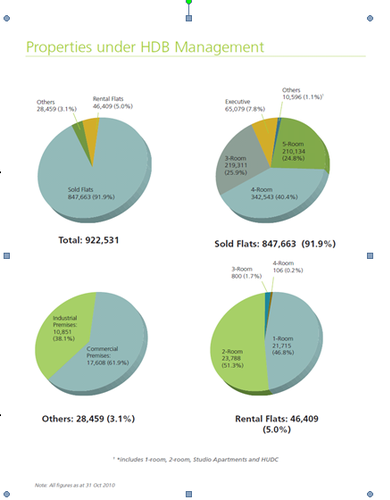
Properties under the Housing and Development Board, the public housing authority in Singapore
5. Parallel Session 2: Social Policies and Social Management for Improving Overall Well-being
5.1 “Social protection and inclusive growth”
|
Rathin Roy, Director, International Policy Centre for Inclusive Growth, UNDP, Macro-economy and social recovery |
Social protection has considerable counter-cyclical value in mitigating impacts of economic turmoil on the poor and promoting a more inclusive recovery. Facing the economic crisis, developing countries adopted different responses based on their development trajectories and capacities. The larger developing countries and the middle income developing countries were able to expand domestic resource ability for countercyclical policies. LICs, on the other hand, were more likely to have restricted fiscal space and to be highly dependent on volatile and procyclical grants (ODA). This is perhaps the binding constraint to developing social protection programmes and ensuring timely response to crises in developing countries.
Social protection for the poor is not only about short term safety nets but also has important medium and long term dimensions by first, being able to reduce the inter-generational transmission of poverty and second, enhance inclusion by building human capital. When designed to improve human capital, social security instruments can also increase productivity and contribute to shifting the nature of employment and asset creation to address the long-term determinants of inequality. Productive safety nets (public works and employment programmes designed within a development framework) can facilitate asset creation and service provision that contribute to enhancing the productivity and gains from productive inclusion for participants and for local communities.
Social security only works to foster inclusive growth when it is included in an overall development strategy combining economic, social and political policies.
Food security agenda also benefits from including a social protection component and thus creating a so-called dual-track approach. This has facilitated food security efforts in Ethiopia, Brazil and South Africa. The twin-track approach is an opportunity to regard inclusivity as a central pillar of food security.
Climate change and increased overall vulnerability may lead to increased demand for social protection when food security and livelihoods are at risk.
|
Wang Sangui, Renmin university Center for the Study of Poverty Reduction, “China’s social development and poverty reduction: important experiences and challenges ahead” |
• Focus on economic development instead of a wider socially inclusive approach has resulted in inequality in terms of both income and social services
• Poverty can be reduced by investing in human capital which further boosts economic development. However, investments must be targeted towards most needy areas and groups to reduce inequality.
• Social service system reforms require fiscal reforms in order to have sufficient funds to subsidize public services.
Three decades before its reform and opening-up in the 1970s, China’s social development exceeded its economic development. Back then, enrollment rate of school-age children, rate of primary school graduates’ admission into junior high school, people’s health conditions, infant mortality and average life span all showed improvement. During those three decades, China experienced remarkable improvement in social services because of the immense incentives derived from its social development mechanism. After the reform and opening-up, however, China paid more attention to economic development. It still achieved some progress in social development, which, though, might not be on comparable basis with the previous three decades. During this time, economic growth shadowed social development.
Social development has a strong impact on poverty reduction. During the last 30 years, China’s large-scale poverty reduction can mainly be attributed to rapid economic growth, especially the growth of agriculture and rural areas. Most notably, human capital (education and health) has played a key role in boosting economic development. Abundant research has shown that education correlates positively with farmers’ income. Education not only directly increases productivity, but also, more importantly, facilitates transfer of labor from agricultural to non-agricultural sectors with greater productivity, thus greatly increasing rural laborer’s income.
Research on the efficiency of poverty reduction input shows that greater rate of returns are found in agriculture, education and health investments. Education investment’s direct influence on poverty reduction is the most obvious among investments in all sectors, higher than investments in agricultural R&D and the construction of infrastructures like roads. International research has shown that investment in health also yields a high rate of return.
Despite considerable progress in social development, China still faces severe challenges posed by inequality. Inequality manifests not only in income, but also in social services. The gap between rural and urban areas in social services is alarming, with rural, especially the poor areas, having social services of a very low level. Another problem is that for both rural and urban areas, there is inequality in the social service quality between different population groups. Disease-incurred poverty, for instance, is acute partly because high medical service expenditures directly impoverish the patient and partly because untimely treatment results in partial or full deprival of the patient’s ability to work, which will lead further to permanent poverty.
Education reform, not compatible with poverty reduction, has also caused many difficulties. Mergers of schools place children from poor families into a disadvantageous position because schools are more expensive and so far away that children have to postpone enrollment as they are too young to go to school on their own. Some boarding schools’ backward living facilities have also resulted in students’ malnutrition.
Given the situation above, China still needs to further carry out a series of reforms. Inadequate social services of the poor people will ultimately widen income gap and elongate poverty. The latter is also likely to cause generation-to-generation poverty. Social policies should prioritize equality and promote equitable public services. This will involve reforms in the fiscal system and human resources system. In terms of the fiscal system, local governments must be secured sufficient funds to subsidize public services. Meanwhile human resources system should be reformed in a way that will attract competent talents to come and provide public services in the poor areas. Last, administration and technical problems also need to be addressed. Some poverty reduction projects, though seemingly effective, cannot bring benefits to the poor. Therefore, relevant policies are needed to make sure that such services or products can bring real benefits to them.
|
Ding Ningning, Development Research Center of the State Council, “The role of NGOs in improving people’s livelihoods and sustainable poverty reduction” |
• NGOs play a key role in poverty reduction in China since they have many natural advantages compared to governments.
• The government is very supportive towards the NGOs as a major force behind poverty reduction and is improving the laws, policies and regulations governing the NGOs.
• NGOs should improve their funding, administration and accountability in order to become more efficient and minimize risk of corruption.
We are constantly improving policies and promulgating regulations to allow the establishment of NGOs. However, some government officials maintained a pessimistic attitude towards NGOs until the Wenchuan Earthquake reversed their misconceptions regarding NGOs. During the earthquake, many NGOs voluntarily participated in disaster relief actions organized by the government, becoming a major force behind the People’s Liberation Army (PLA) and local governments.
The emergence of NGOs is unstoppable. They serve as an important platform for and link between political participation of citizens and social governance by the government. During China’s reform and opening-up, a landscape of diversified social interests came into being, each interest group naturally in need of an NGO to represent its own interest. In system transitions, some public service functions of governments are performed with the help of NGOs or directly through them.
The NGOs have long been playing an important role in poverty reduction. NGOs established with the specific purpose of poverty reduction include China Youth Development Foundation, China Foundation for Poverty Alleviation, China Charity Federation and Stars’ Charity Fund. The first three NGOs have exerted their influences with their projects, the Hope Project, the Self Dependence Project for Poor Farmers and international disaster relief, respectively. NGOs’ voluntary poverty reduction is in a leading position with exemplary significance.
Given China’s imbalanced development, poverty reduction remains an arduous long-term task. According to the international standard, the poor in China account for at least 10% of the total population. NGOs have their own natural advantages in poverty reduction. They work on a voluntary basis with socially responsible members who have their own specialties. NGOs are also closer to the public and thus can help the government to identify target groups in the socio-economic development plans. NGOs’ participation in the public service sector, in particular, not only increases the transparency of government policies, reduces rent-seeking of public power, but also helps to control the scale of governments and reduces the cost of public administration.
The Chinese government is very supportive towards NGOs, especially when it comes to poverty reduction. The 87 Poverty Reduction Program and the Development-oriented Poverty Reduction Program for Rural China, both have identified NGOs as a major driving force behind poverty reduction. Further, policies, laws and regulations on NGOs are being improved in every aspect.
NGOs also need to strengthen their endogenous capacity building and improve their governance structures and accountability system. Democratic administration and policy-making should be achieved to enhance self-regulation and social credibility of NGOs. They should, while soliciting government support and preferential policies, mobilize every possible force to expand funding channels and improve funding mechanisms, so as to enhance their own ability in poverty reduction. All donation and poverty reduction projects are subject to third-party supervision to increase efficiency and eliminate corruption.
In addition, China’s NGOs will benefit the world as a whole with their poverty reduction projects. First, China’s poverty reduction achievements have provided a good example for developing countries. Second, in natural disaster relief, China’s NGOs have already fulfilled their responsibility and have become a key player in China’s international disaster relief activities. With China’s economic development and the reduction of poor population, China’s NGOs and the Chinese government are bound to shoulder more international obligations and contribute to global poverty reduction.
5.2 Pro-poor policies, health reform implementation in poor areas
|
Dai Tao, Director, Medical Information Research Institute, China Academy of Medical Sciences, “China’s practice in rural health reform: experience and challenges” |
• Greatest challenges facing the rural health reform include shortage of staff and equipment, rural residents’ lack of financial resources to pay for services, unwillingness of medical staff to work in rural areas, loss of educated workforce via rural-urban migration, and lack of comprehensive health security system covering flowing migrant population
• Developing a rural health team system is part of the solution
Since its reform and opening-up, the Chinese government has been committed to the construction and reforms in the rural health system. However, given the greater backdrop of the economic system reform, social transformation and population flow, such an undertaking is faced with great challenges.
China’s rural health reform has yielded some results. The new rural cooperative medical care has been improved in terms of coverage, protection level and basic expenditure. In medical services, a medical service network featuring county-level, village-level and sub-village level medical institutions is promoted to comprehensively develop rural medical services, increasing the usages of these institutions. Public health projects are also pressing ahead, with their coverage and rate of return rising. There are also more human resources and inputs invested in rural health care. We have also witnessed remarkable increase in the number of institutions, human resources
and input in rural health care. Looking at diseases-incurred death in the rural areas, the death rate of communicable diseases is decreasing while the rate of non-communicable diseases is increasing, a fact showing that the rural health model is evolving towards that of the urban areas.
Challenges still abound in this reform. Poor and backward areas are restricted by their economic development level, and therefore naturally lack health input. They still face issues relating to human resources such as the shortage, irrational structure and losses of human resources. Further, rural areas are less developed economically, resulting in residents’ low income level that is bound to suppress health service demand. Investment shortage on the part of the government may explain why surplus labors of the urban areas or college graduates are unwilling to work in the rural area. Meanwhile, quite a lot of talents with medium or even higher education status are flowing from the rural area to cities. China is currently lagging behind in the construction of a health security system for its floating population. The existing medical care system is highly dependent on a person’s household registration or employer. When compared with urban residents, migrant workers with high mobility receive much less protection.
In the future, the health care reform should prioritize the rural area and pay special attention to the construction of infrastructures and systems, in order to further improve the health service network, integrating county, village and sub-village level institutions and to construct a public health system in the poor rural area. China should also, through combining the new rural cooperative medical system and national basic drugs system, gradually establish an integrated and highly efficient health service and protection system. The central and local health finances should allocate more of their funds into poor areas to support health development there. It is also important to secure special funds and other funding channels outside the health system, including government departments, NGOs, international organizations and so on. The training and incentives for rural health teams should be enhanced, including periodic free training to targeted personnel, so as to nurture more talents in rural health teams. These teams are hopefully to become long-terms ones with incentives in forms of economic and employment terms, career prospects, administration system and social status.
|
Rudy S. Prawiradinata, Director of Poverty Reduction, Ministry of National Development Planning, Indonesia, “Poverty in Indonesia” |
Indonesia’s poverty dimensions can be summarized as vulnerability, inequality and interregional disparity. Even though poverty situation has improved in the past years, the decrease in poverty has been slowing down and the disadvantaged still account for a significant number of the population.
The national development strategy aims at being pro-growth, pro-job, pro-poor and pro-environment. Indonesia is, at the moment, in the second phase of the long-term development plan.
Indonesia is aiming at establishing a universal coverage social security system with priority for the poor. Biggest challenges identified are related to the transformation of government social security companies from “profit-oriented” to “non-profit”, and to reaching universal coverage.
Currently, Indonesia has five key poverty reduction areas: community empowerment, family planning, empowerment of micro and small scale enterprises (MSEs), improving access to basic
Poor population of Indonesia (1976-2011)
services and socio-economic policies aiming at increasing purchasing power. Major poverty alleviation programs include National Program on Community Empowerment, Indonesian Conditional Cash Transfer Program and Unconditional Cash Transfer.
The National Program on Community Empowerment is based on community-driven development (CDD) approach and aims at increasing community capacity and self-help in order to create employment opportunities and thus achieve a higher standard of community welfare. It also acts as a safety net mechanism.
The Indonesian Conditional Cash Transfer Program was designed to achieve compulsory basic education. The conditions for receiving cash transfers are attending pre-natal checkups, vaccinating children and enrolling children in school with minimum 85 % attendance. In addition to increasing children and their families’ wellbeing, the program lowers inequalities and poverty, reduces child labour and improves health and education services by increasing demand.
5.3 Child development, education and poverty reduction
|
Bill Bikales, Chief, Social Policy and Reform for Children, UNICEF China, “Child poverty: some key findings from China” |
• Different dimensions of child poverty (food, water, shelter, sanitation, health, education, information) are not only related to parents’ income but also depend on availability of public services
• China’s most serious child poverty manifests in pre-school education, access to safe drinking water and housing
• Parents’ migration may have serious effects on children’s physical and mental wellbeing
Poverty is multi-dimensional and not solely limited to income. The most obvious example is child poverty, because children can barely make any money. Child poverty means that a child’s lack of basic services and resources deprives them of living necessities and a sound development towards a physically healthy and psychologically mature adult.
There are seven dimensions to measure child poverty, which are directly related to the necessary resources and basic rights of a child, including food, water, shelter, sanitation, health, education and information. Many researchers have indicated that income poverty of adults is not an effective method to measure multi-dimensional child poverty. In fact, while many people are not living in income poverty, many children still face at least one severe deprivation of the seven dimensions. Research regarding Lao PDR, Cambodia, Mongolia, Philippines, Thailand and Vietnam has shown that there are altogether 33 million children suffering from severe deprivations in these countries, with 13 million more suffering lower levels of deprivations. China has its own problems in this respect as well. Research in some rural areas of Gansu and Hubei provinces indicates that child income poverty incidence is higher than that of adult, because poor people tend to have more children which lower their per capita income.
China’s most serious child poverty can be seen in the following areas: pre-school education, access to safe drinking water and housing. Access to safe drinking water and housing is related to income, while nutritional health and pre-school education are not directly linked to economic poverty. In fact they are mainly linked to government services.
Looking further at the relationship between income and child poverty from the perspective of migration, researchers have discovered that when parents migrate to cities for employment, their family income will rise, but it won’t necessarily lead to a better living environment for the child. Researchers in some regions have also discovered that low weight rate and stunting were slightly higher among children whose mother had left home to seek employment. The problem becomes more severe when looking at psychological issues. A lack of parents’ love and being far away from them will have an impact on child’s psychology.
Compared with other countries, China fares better in child poverty reduction according to existing surveys. Every child counts in China’ aging society and all of them are entitled to the same basic rights and services. This is not only a moral issue, but also a fundamental challenge of China, for every child has the prospect of growing into a healthy and efficient social contributor.
6. Plenary Concluding Session: Summary
|
Cyprian Fisiy, Director of the Social Development Bureau, World Bank |
The 2011 international poverty reduction and sustainable development forum can be summarized into five key points:
1) Relationship between development and inequality.
2) Relationship between urban and rural areas.
3) Need for inclusive development.
4) Need for social protection.
5) Need for concrete actions.
Despite economic growth, inequality, measured both with income and opportunities, is worsening. Traditionally poverty concentrates in remote areas lacking investments and employment opportunities. However, because of growing urbanization, cities are expected to see increasing poverty incidence. Therefore, social policies are needed to guarantee sustainable urban development and to address issues related to rural-urban migration.
China’s quest for reaching harmonious society is facing the following four challenges: land issues, migration, inequality and aging population. Land provides people with a basic living guarantee. Land expropriation fuelled by urbanization deprives people of their means of survival. Therefore, to reduce poverty and dependence on land as a sole source of income, people need capacitating in other skills.
Inequality touches especially minorities and vulnerable groups. There is a strong link between inequality and poverty. Besides populations living in remote areas restricted by structural and geographic conditions, gender and unemployment are also major contributors to social exclusion. Lack of employment is directly related to people’s dignity and self-worth.
Poverty reduction should always be inclusive and aim at empowering the poor. In order for poverty reduction to be sustainable, the mechanisms have to be locally-tailored. Low-income population has to be guaranteed a basic living standard and services, then establish a social safety net as a foundation for future development, and finally develop social security and insurance systems with universal coverage. All of these institutions must be accountable, inclusive and inherent.

扫描下载手机客户端
地址:北京朝阳区太阳宫北街1号 邮编100028 电话:+86-10-84419655 传真:+86-10-84419658(电子地图)
版权所有©中国国际扶贫中心 未经许可不得复制 京ICP备2020039194号-2

